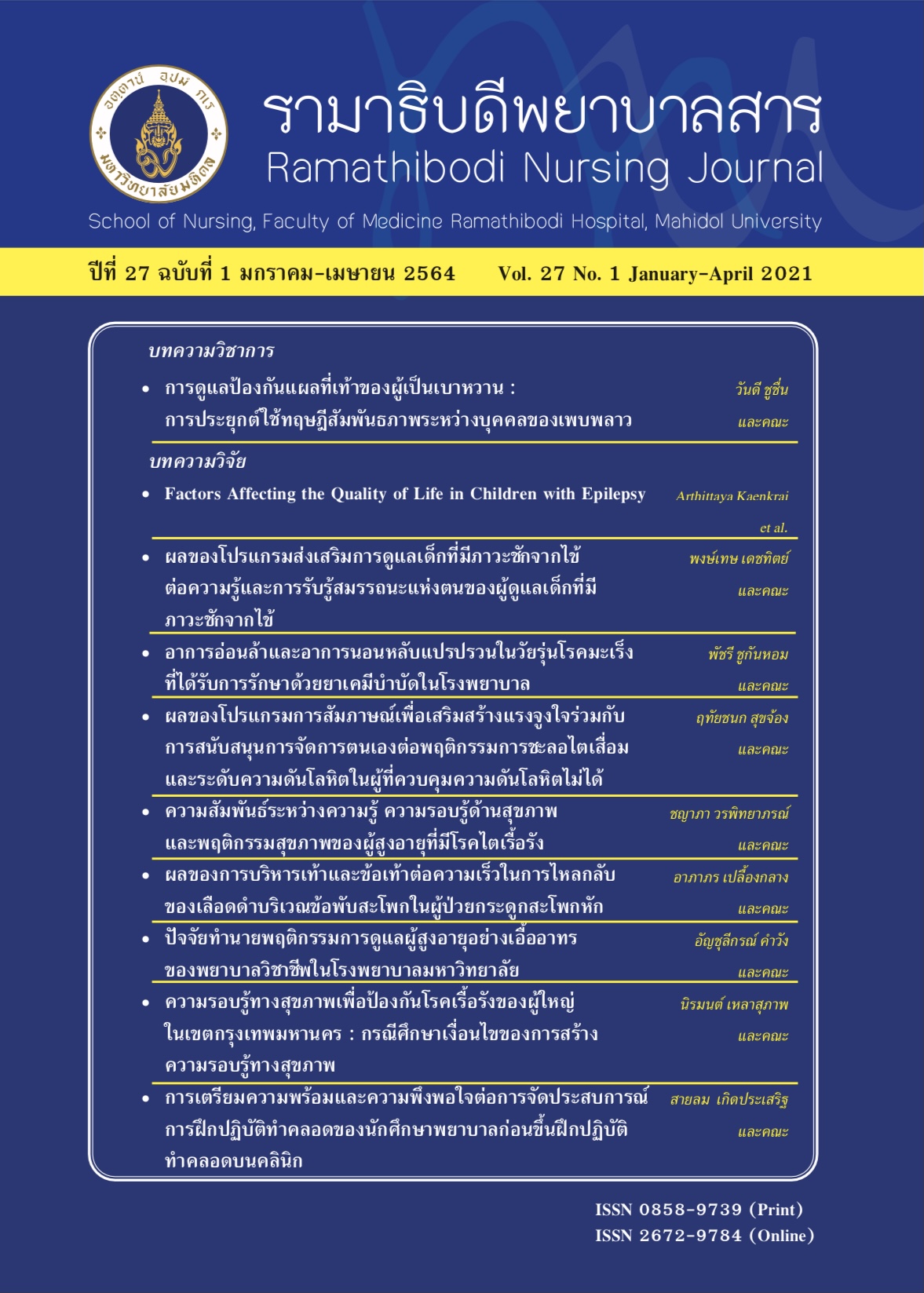การเตรียมความพร้อมและความพึงพอใจต่อการจัดประสบการณ์การฝึกปฏิบัติทำคลอดของนักศึกษาพยาบาลก่อนขึ้นฝึกปฏิบัติทำคลอดบนคลินิก
Main Article Content
บทคัดย่อ
การวิจัยเชิงพรรณนาครั้งนี้มีวัตถุุประสงค์เพื่อศึกษาวิธีการเตรียมความพร้อมและความพึงพอใจต่อการจัดประสบการณ์การฝึกปฏิบัติทำคลอดของนักศึกษาพยาบาลก่อนขึ้นฝึกปฏิบัติทำคลอดบนคลินิก โดยใช้กรอบแนวคิดรูปแบบการเรียนรู้ของคอล์บในการศึกษา การเตรียมความพร้อมนักศึกษา 5 รูปแบบ คื อ 1) การสาธิตการทำคลอดกับหุ่นจำลองโดยอาจารย์พยาบาล 2) วีดิทัศน์การทำคลอด 3) แบบประเมินขั้นตอนการทำคลอด 4) การฝึกทำคลอดกับหุ่นจำลองของนักศึกษาร่วมกับเพื่อน และ 5) สมุุดคู่มือการทำคลอด กลุ่มตัวอย่างเป็นนักศึกษาพยาบาลชั้นปีที่ 4 จำนวน 113 ราย ได้รับประสบการณ์การเรียนรู้ทั้ง 5 รูปแบบก่อนขึ้นฝึก 2 สัปดาห์ เก็บข้อมูลโดยใช้แบบสอบถามความคิดเห็นของนักศึกษาถึงวิธีที่ทำให้มีการเตรียมความพร้อมมากที่สุด ความพึงพอใจต่อวิธีการจัดการเรียนการสอน และสัมภาษณ์กลุ่มนักศึกษาจำนวน 30 ราย ถึงเหตุผลของการใช้แต่ละวิธีและข้อเสนอแนะ วิเคราะห์ข้อมููลโดยใช้สถิติพรรณนาและการสรุปประเด็นสำคัญของข้อมููลจากการสัมภาษณ์ ผลการศึกษาพบว่า นักศึกษามีความพึงพอใจต่อวิธีการเตรียมความพร้อมโดยการฝึกทำคลอดกับหุ่นจำลองของนักศึกษาร่วมกับเพื่อนมากที่สุด รองลงมาเป็นการใช้แบบประเมินขั้นตอนการทำคลอด การสาธิตการทำคลอดกับหุ่นจำลองโดยอาจารย์พยาบาล การศึกษาจากวีดิทัศน์การทำคลอด และการใช้สมุุดคู่มือการทำคลอด ตามลำดับ นอกจากนี้จากการสัมภาษณ์กลุ่ม พบว่านักศึกษามีข้อเสนอแนะให้ลดจำนวนนักศึกษาต่อกลุ่ม ในการสาธิตการทำคลอดกับหุ่นจำลองลงและเพิ่มจำนวนหุ่นจำลองในการฝึกกับเพื่อนให้มากขึ้น สำหรับวีดิทัศน์ ควรแบ่งเป็นตอนให้สั้นลง เพื่อให้เปิดได้ง่ายใส่ภาพประกอบในสมุดคู่มือการทำคลอดเพื่อให้เข้าใจง่ายขึ้น ข้อมูลที่ได้เป็นประโยชน์สำหรับอาจารย์
ที่สอนการทำคลอดให้มีการจัดประสบการณ์การเรียนรู้ที่ตอบสนองต่อความต้องการของนักศึกษาก่อนขึ้นฝึกปฏิบัติการทำคลอด
คำสำคัญ : การเตรียมความพร้อม ความพึงพอใจ นักศึกษาพยาบาล ประสบการณ์การเรียนรู้
Article Details

อนุญาตภายใต้เงื่อนไข Creative Commons Attribution-NonCommercial-NoDerivatives 4.0 International License.
บทความ ข้อมูล เนื้อหา รูปภาพ ฯลฯ ที่ได้รับการตีพิมพ์ในรามาธิบดีพยาบาลสาร ถือเป็นลิขสิทธิ์ของวารสาร หากบุคคลหรือหน่วยงานใดต้องการนำทั้งหมดหรือส่วนหนึ่งส่วนใดไปเผยแพร่หรือเพื่อกระทำการใด ใด จะต้องได้รับอนุญาตเป็นลายลักษณ์อักษรจากรามาธิบดีพยาบาลสารก่อนเท่านั้น
เอกสารอ้างอิง
Thailand Nursing and Midwifery Council. Nursing and midwifery practice standard. [Internet]. 2014 [cited 2020
Dec 4]; Available from: https://sites.google.com/site/sonthayasite/article7/law7-4/7-4-18
Neamsakul W. The first time experiences to assist in childbirth of the third year nursing students. Boromarajonani College of Nursing, Uttaradit Journal. 2017;9(2):1-17.(in Thai)
Limruangrong P, Athaseri S, Sugreetoon S. Stress and coping process during the practice in labour room of the
nursing students, Faculty of Nursing, Mahidol University.Journal of Nursing Science. 2002;20:49-65. (in Thai)
Mayer RE. Research-based principles for designing multimedia instruction. In: Benassi VA, Overson CE,
Hakala CM, editors. Applying science of learning in education: infusing psychological science into the
curriculum; [internet]; 2014 [cited 2020 June 5];Available from: https://psycnet.apa.org/ record/ 2013-
-005
Chuang YH, Lai FC, Chang CC, Wan HT. Effects of a skill demonstration video delivered by smartphone on
facilitating nursing students’ skill competencies and selfconfidence:a randomized controlled trial study. Nurs EducToday. 2018;66:63–8.
Gerdprasert S, Phumornsakorn S. Nursing students and instructors’ perception of learning and teaching in
midwifery’ clinical skill laboratory before clinical practice.Ramathibodi Nursing Journal. 2013;19:400-16. (in
Thai)
Haraldseid C, Friberg F, Aase K. Nursing students’perceptions of factors influencing their learning environment in a clinical skills laboratory: a qualitative study. NursEduc Today. 2015;35:e1-e6.
Houghton CE, Casey D, Shaw D, Murphy K. Staff and students’ perceptions and experiences of teaching and
assessment in clinical skills laboratories: interview findings from a multiple case study. Nur s Educ Today.
;32:621-728.
Wright C, Hogard E, Ellis R, Smith D, Kelly C. Effect of PETTLEP imagery training on performance of nursing
skills. J Adv Nurs. 2008;63:259–65.
Oermann MH, Muckler VC, Morgan B. Framework for teaching psychomotor and procedural skills in nursing. J
Contin Educ Nurs. 2016;47:278–82.
Lamont S, Brunero S, Woods KP. Satisfaction with clinical placement-the perspective of nursing students from
multiple universities. Collegian. 2015;22:133-5.
Smitha MR, Grealish L, Hendersonc S. Shaping a valued learning journey: student satisfaction with learning in
undergraduate nursing programs, a grounded theory study.Nurs Educ Today. 2018;64:175–9.
Milton-Wildey, Kenny P, Patricia G, Hall J. Educational preparation for clinical nursing: the satisfaction of students and new graduates from two Australian universities. Nurs Educ Today. 2014; 34:648–54.
Kolb D. Experiential learning. New Jersey: Prentice HallInc; 1984.
Poore JA, Cullen DL, Schaar GL. Simulation-based interprofessional education guided by Kolb’s experiential
learning theory. Clin Simul Nurs. 2014;10(5):e241-e247.
Kosir MA, Fuller L, Tyburski J, Berant, L, Yu M. The Kolb learning cycle in American Board of Surgery intraining
exam remediation: the accelerated clinical education in surgery course. Am J Surg. 2008;196(5):657-662.
Konak A, Clark TK, Nasereddin M. Using Kolb’s experiential learning cycle to improve student learning in
virtual computer laboratories. Comput Educ. 2014;72:11-22.
Gyeong JA, Myung SY.Critical thinking and learning styles of nursing students at the baccalaureate nursing program in Korea. J Cont Educ Nurs. 2008;29:100–9.
Palsson Y, Martensson G, Swenne CL, Adel E, Engstrom M. A peer learning intervention for nursing students in clinical practice education: a quasi-experimental study.Nurs Educ Today. 2017;51:81-7.
Ryan M, Ryan M. Theorizing a model for teaching and
assessing reflective learning in higher education. High Educ
Res Dev. 20131;32(2):244-57.
Sternberg RJ, Sternberg K. Cognitive theory. 7th ed.Boston: Cengage learning; 2017.
Bastable SB. Nurse as educator: principles of teaching and learning for nursing practice. 5th ed. Massachusetts: Jones& Bartlett learning; 2019.
Sowan AK. Multimedia applications in nursing curriculum:the process of producing streaming videos for medication administration skills. Int J Med Inform. 2014;83(7):529–35.
Dale, E. Audio-Visual methods in teaching (3rd ed). Holt, Rinehart & Winston, New York: Dryden Press; 1969.


